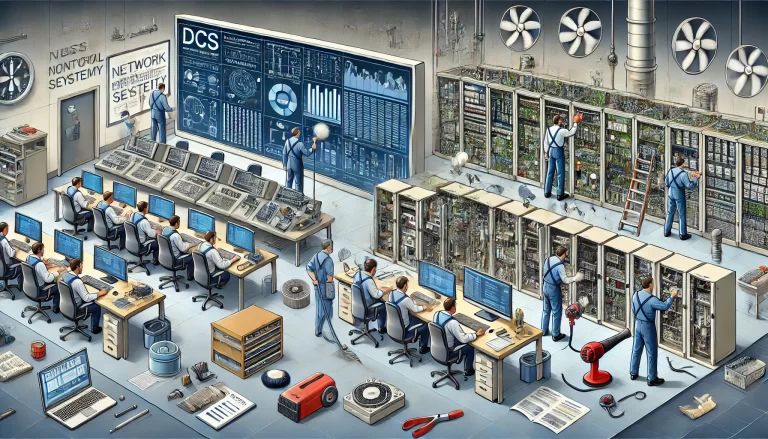Introduction
Distributed Control Systems (DCS) have become an indispensable technology in modern industrial automation, widely used in industries such as oil, chemicals, and power generation. As the demands for industrial automation continue to grow, the load capacity of DCS systems faces increasing challenges. To effectively meet large-scale control needs, relays, a simple yet efficient electrical control component, play a crucial role. This article explores how relays can enhance the load capacity of DCS systems, particularly in expanding I/O channels and increasing control capabilities.
1. Load Capacity in DCS Systems
In the context of DCS, load capacity refers to the system’s ability to handle the number of input/output (I/O) signals, control load ranges, and manage electrical loads simultaneously. It includes the number of devices the system can control, the electrical load (current or voltage) each device imposes, and the system’s ability to control external devices. As automation equipment increases, DCS systems require stronger capabilities to expand I/O channels, process more signals, and ensure the system runs stably under heavier loads.

2. Role of Relays in DCS Systems
Relays are common switching devices in automation control systems that can control large electrical loads. In DCS systems, relays serve several critical functions:
Expanding Output Capabilities: DCS control modules often have limited output channels. By connecting relays to the control module’s output ports, the system can control more external devices or electrical loads. Each relay can control multiple electrical devices, enhancing the DCS system’s load capacity.
Signal Isolation: Relays provide effective signal isolation, preventing high current from directly affecting the control part of the DCS system, thus ensuring system stability. The relay acts as a buffer between the control system and high-power external devices, enhancing load capacity without overburdening the control module.
Distributing Control Tasks: Relays perform switching operations based on input signals, distributing control tasks among various devices, ensuring that each device starts as required. By configuring relays properly, DCS systems can flexibly allocate control across multiple devices, allowing the system to manage a larger load efficiently.

3. Methods for Enhancing DCS System Load Capacity Using Relays
Relays enhance the load capacity of DCS systems in several ways:
3.1 Expanding I/O Channels
In many industrial applications, DCS control modules may face situations where output channels are insufficient. Relays can extend the I/O capabilities of the system by adding external control devices. For example, relay racks can be connected to DCS output ports, allowing relays to control more external devices, enabling the system to handle more loads simultaneously.
Example: In large-scale automation systems, DCS output channels might not be enough to control all devices directly. By using relay racks, the system can control multiple pumps, valves, or heaters, avoiding limitations caused by a lack of output channels and enabling further system expansion.
3.2 Increasing Current Handling Capacity
Relays are particularly effective in managing large current loads, reducing the need for the control module to directly interface with high-power equipment. Relays enable the DCS system to control high-load electrical devices while protecting the control module from current overload.
Example: In power systems, DCS may need to control high-current devices, such as motors or heaters. Relays can control these devices without subjecting the DCS control module to heavy electrical loads.
3.3 Enhancing System Redundancy and Reliability
Relays can be configured to improve the redundancy and reliability of DCS systems. In critical applications, relays can be part of a dual-circuit system, switching to a backup circuit if the main circuit fails, ensuring continuous operation.
Example: In a petrochemical plant, relay redundancy configurations allow the backup circuit to activate in case of a failure in the main control loop, preventing production downtime and ensuring system reliability and continuity.
3.4 Supporting Multi-Device Control
Relays help DCS systems manage multiple control tasks, easing the burden on a single control module. Relays distribute control signals among different devices, allowing them to operate simultaneously without overloading the control system.
Example: In a DCS that controls multiple production lines, relays can allocate switching tasks to several pumps or valves, reducing the load on the system’s control module. This improves the overall efficiency and response time of the system.

4. Installation and Maintenance Considerations for Relays in DCS Systems
While relays play a vital role in enhancing the load capacity of DCS systems, their installation and maintenance require special attention to ensure optimal performance:
Selecting the Right Relays: Relays must be chosen according to the electrical current, voltage, and specific requirements of the load. It’s crucial to ensure the relay’s rated capacity exceeds the actual load demand to prevent malfunction or failure.
Proper Wiring: Relay installation should follow a clear wiring strategy to avoid overloads, short circuits, or other issues that could affect the system’s stability.
Routine Inspections and Maintenance: Relays are mechanical components, and their contacts can wear out over time. Regular checks and timely replacement of aging relays are necessary to prevent control system failures, which could impact the overall load capacity of the system.

5. Conclusion
Relays, as simple yet highly efficient electrical control components, play a crucial role in enhancing the load capacity of DCS systems. Through their application, DCS systems can expand I/O channels, increase current handling capacity, improve redundancy, and support efficient multi-tasking management. Proper selection, installation, and maintenance of relays will provide DCS systems with stronger control capabilities and higher reliability, enabling them to meet the growing demands of industrial automation.
